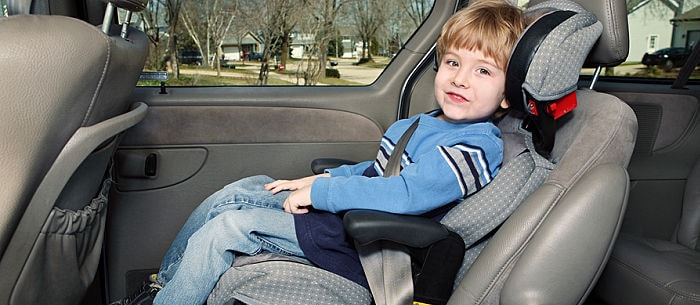After your child has been in a forward-facing car seat for a few years, you may be wondering when he can graduate to a booster seat. Safety always comes first when riding in the car, and with that in mind, this guide can help you figure out booster seat age and weight requirements to see if your child is ready to make the transition.
Use the Safest Choice
The safest option for your child is a car seat with a five-point harness. “It’s always preferable for a child to be in a harnessed seat because it’s the safest way to ride,” advises Eli Gurock, the founder of parenting store Magic Beans, which sells car seats along with other baby items. “Race car drivers drive in a harnessed seat because it slows down the forces of a crash and makes you less likely to be ejected. If it’s good enough for a race car driver, it should be good for your 6-year-old.” Try to keep your child in her forward-facing car seat for as long as possible.
Keep that in mind as you look at booster seat age or weight requirements, and start your search by focusing on your child’s current car seat. “Parents shouldn’t think about a minimum age or weight of a booster seat,” says Jessica Jermakian, a senior research scientist at the Insurance Institute for Highway Safety (IIHS).
“Rather, they should pay attention to the maximum weight for the forward-facing car seat their child is using prior to moving up to a booster.” Check your current car seat’s manual for maximum booster seat weight guidelines. Some go as high as 80 pounds, meaning many children can ride in them until they’re 7 years old.
In addition to age and weight, you must also consider your child’s personality. “Moving to a booster and using the lap and shoulder belt gives more freedom to move around, which may not be good for a younger child,” Jermakian cautions. The majority of children start using booster seats between 5 and 7 years of age, but before you put kids in a booster seat, you should feel confident that they’ll be able to sit still in the car and keep the belt in the right position for optimal safety.
Choosing the Right Booster Seat
When your child is finally too big for the forward-facing seat, it’s time to graduate to a booster seat. You’ll need to check the minimum height and weight requirements for each specific model to see if it’s appropriate. While shopping, you’ll generally find two kinds: those with a back and those without. Both provide protection, but Gurock recommends booster seats with a back. “A high-back booster is the best because it has extra side impact protection for the child’s head and shoulders,” he says.
Regardless of which kind of seat you choose, the most important part is to make sure the belt fits properly. The shoulder strap should fit across the center of the shoulder, according to Jermakian. “The lap belt should lie flat across the upper thighs and not on the soft tummy,” she adds. The IIHS provides pictures and ratings for several seats based on belt fit. Bring your child and your car to test out booster seats and confirm that the belt fits properly before purchasing one.
To make sure your child is in the safest seat possible, verify that he easily surpasses the minimum age requirements, is the right booster seat weight and has outgrown the forward-facing seat. Don’t rush through the use of booster seats, either. The American Academy of Pediatrics encourages parents to keep kids in a booster seat until they are anywhere from 8 to 12 years old and at least 57 inches tall. That’s the height at which seat belts begin fitting kids correctly for the best protection.
And check out these Booster Seat Requirements.
Jessica Woodbury blogs about life and single parenting at Don’t Mind the Mess. She lives in Boston with her two children.




